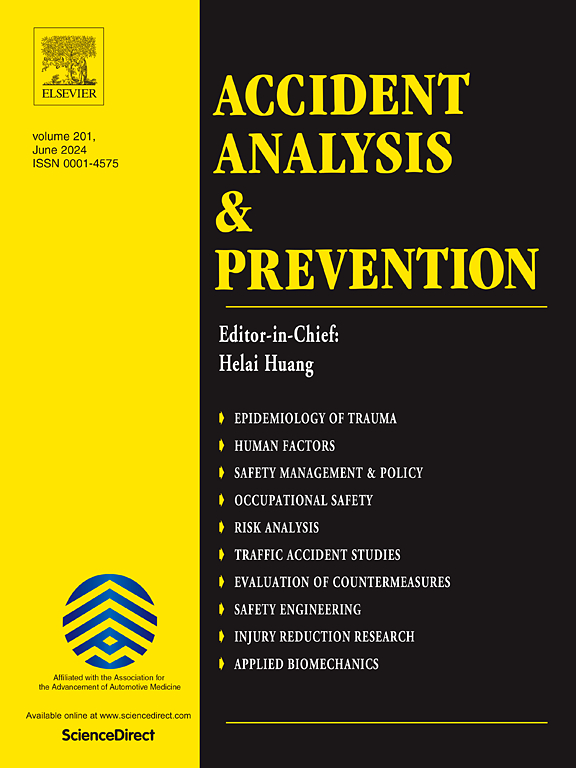Evaluating crash risk factors of farm equipment vehicles on county and non-county roads using interpretable tabular deep learning (TabNet)
IF 5.7
1区 工程技术
Q1 ERGONOMICS
引用次数: 0
Abstract
Crashes involving farm equipment vehicles are a significant safety concern on public roads, particularly in rural and agricultural regions. These vehicles display unique challenges due to their slow-moving operational speed and interactions with faster vehicles, often leading to severe crashes. This study analyzed crashes involving farm equipment vehicles to examine the factors influencing crash severity, with a particular focus on comparing incidents on county roads to those on non-county roads. The dataset included key variables such as road geometry, lighting conditions, and traffic interactions, with preprocessing techniques like Synthetic Minority Over-sampling Technique (SMOTE) applied to address class imbalance. The TabNet model, a tabular deep learning model, was employed to analyze crash dynamics, offering both predictive accuracy and interpretability through feature importance and SHapley Additive exPlanations (SHAP) plots.
Findings revealed that crash severity on county roads is primarily influenced by crash speed limit, first harmful event, traffic control, and person age, reflecting the role of road geometry and demographic risk in rural settings. In contrast, non-county roads were more affected by lighting conditions, intersection-related features, and population group, emphasizing the impact of visibility and traffic complexity in urban areas. Speed limit consistently emerged as a critical factor across all road types and severity levels. The study emphasized the need for targeted safety interventions, including visibility enhancements, speed management, and enhanced education campaigns for county and non-county areas.
基于可解释表格深度学习(TabNet)的农用设备车辆在县域和非县域道路上碰撞风险因素评估
涉及农用设备车辆的撞车事故是公共道路上的一个重大安全问题,特别是在农村和农业地区。这些车辆由于其缓慢的运行速度和与更快的车辆的相互作用而面临独特的挑战,经常导致严重的撞车事故。本研究分析了涉及农用设备车辆的碰撞事故,以检查影响碰撞严重程度的因素,特别侧重于比较县道路上的事故与非县道路上的事故。该数据集包括关键变量,如道路几何形状、照明条件和交通交互,并使用预处理技术,如合成少数过度采样技术(SMOTE)来解决类别不平衡问题。TabNet模型是一种表格式深度学习模型,用于分析碰撞动力学,通过特征重要性和SHapley加性解释(SHAP)图提供预测准确性和可解释性。研究结果表明,县域道路碰撞严重程度主要受碰撞速度限制、首次有害事件、交通管制和人的年龄的影响,反映了道路几何形状和人口风险在农村环境中的作用。相比之下,非县域道路更受照明条件、交叉口相关特征和人口群体的影响,强调了城市地区能见度和交通复杂性的影响。在所有道路类型和严重程度中,速度限制一直是一个关键因素。该研究强调了有针对性的安全干预措施的必要性,包括提高能见度、速度管理和加强对县和非县地区的教育活动。
本文章由计算机程序翻译,如有差异,请以英文原文为准。
求助全文
约1分钟内获得全文
求助全文
来源期刊

Accident; analysis and prevention
Multiple-
CiteScore
11.90
自引率
16.90%
发文量
264
审稿时长
48 days
期刊介绍:
Accident Analysis & Prevention provides wide coverage of the general areas relating to accidental injury and damage, including the pre-injury and immediate post-injury phases. Published papers deal with medical, legal, economic, educational, behavioral, theoretical or empirical aspects of transportation accidents, as well as with accidents at other sites. Selected topics within the scope of the Journal may include: studies of human, environmental and vehicular factors influencing the occurrence, type and severity of accidents and injury; the design, implementation and evaluation of countermeasures; biomechanics of impact and human tolerance limits to injury; modelling and statistical analysis of accident data; policy, planning and decision-making in safety.
 求助内容:
求助内容: 应助结果提醒方式:
应助结果提醒方式:


